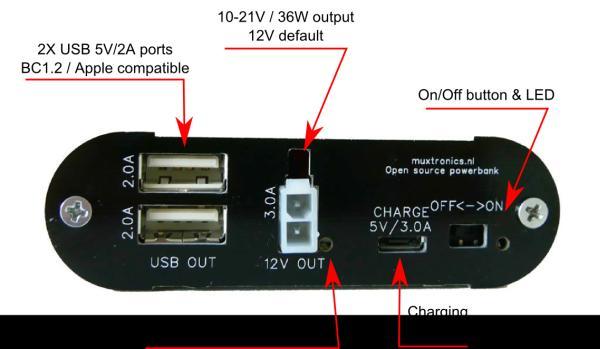Summary of Open source 12V powerbank
The article explains the motivation for building a custom 12V power bank suited for charging high-end tablets, which are not well served by existing commercial options. The available power banks are either not powerful enough, too expensive, or unsuitable due to varying output voltages and proprietary connectors. Many cheap models use Quick Charge 2.0, which is incompatible with generic 12V devices. Expensive models offer good specs but are heavy and costly, while mid-range options don't meet the current requirements or price expectations. Therefore, a DIY approach is proposed to create a suitable, affordable 12V power bank.
Parts used in the Open source 12V powerbank:
- Li-ion battery pack
- Voltage regulator for 12V output
- USB ports (for 5V output)
- Battery protection circuitry
- Connectors compatible with tablet charging ports
- Charging circuit compatible with safe Li-ion charging
- Enclosure for portable housing
Why did I build a power bank?
Why would anyone even try to build a power bank – i.e. an external battery for charging mobile devices – these days? These things are commodity, it’s impossible to compete. Right? Well, that is until you find out that the type of power bank for your application, namely charging a higher-end tablet with 12V input, does not exist cheaply. Looking around for 12V power banks yields a lot of li-ion car jumpstarters (*) and very few actual power banks. Those that exist are pretty expensive and often don’t even perform that well. Let’s run down the list:

| Name (linked) | Capacity | Price | Comments |
|---|---|---|---|
| (no-name) Portable PowerBank with 12V & 5V USB | Approx. 90Wh | $71.99 | Big and heavy: weighs 650g. Output power 60W max. Seems to actually be for solar applications. Very little information. |
| XTPower MP-10000 with dual USB and DC 9V/12V 2A | 37Wh | $59.90 | Output is limited to 2A. Auto turn-off is nice. Weight is ok (300g). Includes lots of connectors. |
| RAVPower Xtreme 23000mAh | Approx. 85Wh | $99.99 (normal: $299.99) | Pretty big and heavy (600g), very nice design. Super expensive. High output power. |
| Qualcomm BlitzWolf QC2.0 | Approx. 35Wh | $26.99 | Low output power (12V/1.35A), uses QC2.0 instead of general purpose output |
(*) Car jumpstarters will not work, because they have a 3S pack of li-ion cells directly connected to the output, meaning the output actually varies from about 10-12.6V. My tablet (Cube i7 Stylus) and the Microsoft Surface series only accept 12V +/- 5%
Prices exclude shipping. I tried my best to include an example of every ‘category’ of available power bank in this list, but there are obviously hundreds. They fall into four general categories:
- QC2.0 chargers, which use the new Quick Charge protocol to deliver 5-12V at up to 18W to supported mobile devices. These are the only ‘cheap’ 12V power banks, but unfortunately also woefully underpowered as well as using a communication protocol on the charging port. That makes it very hard to use as a generic 12V charger for a tablet.
- Ridiculously expensive chargers. There are a bunch, and they all retail for between 100-400 dollars. Some are specifically marketed towards high-end laptop/audio/photographic gear. They do have really good specs (often up to 4-6A outputs and variable output voltage), but are also generally heavy and very proprietary in their connections.
- ‘Almost there’ power banks. There are a lot of 12V/1.5A and 12V/2A power banks in the $60-100 price range. Unfortunately, I need 2.5A to be able to charge AND use my tablet and $60 is a bit on the high side, especially with more than $15 shipping (to Europe). Locally, these tend to retail for €100+.
- Weird application-specific stuff. I put in a solar charger. Often without satisfactory documentation
So, how do we fix this? Well, build your own.
Read more: Open source 12V powerbank
